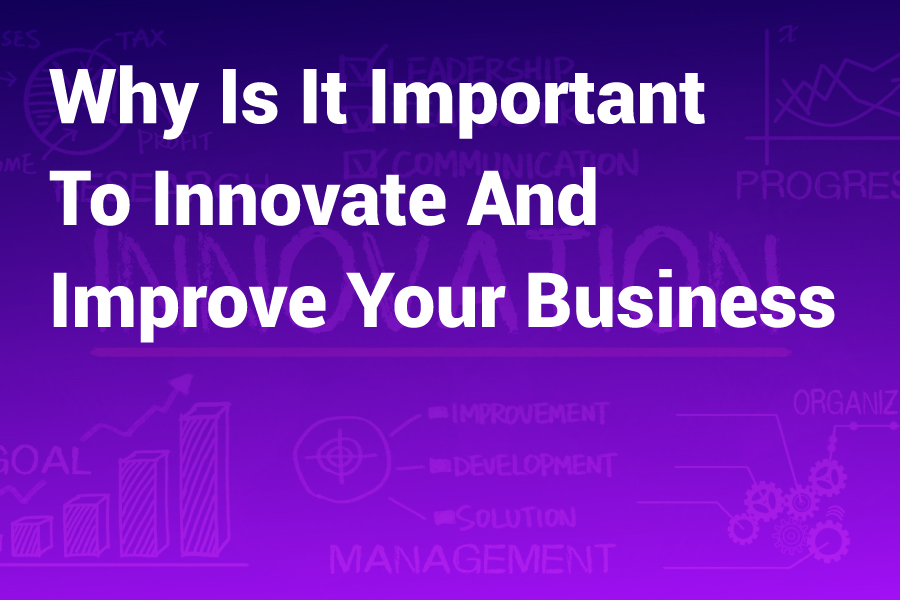
In today’s rapidly evolving business landscape, standing still is the fastest way to fall behind. Markets shift, technologies advance, and customer expectations change at lightning speed. The question isn’t whether your business can afford to innovate—it’s whether you can afford not to. Understanding why is it important to innovate and improve your business has become essential for leaders who want to build organizations that thrive rather than merely survive in the modern economy.
The Competitive Advantage of Innovation
Innovation creates differentiation in crowded markets where products and services quickly become commodities. When you continuously improve your business, you develop unique value propositions that set you apart from competitors. This differentiation translates into pricing power, customer loyalty, and market share that competitors struggle to replicate.
Consider how companies like Apple and Tesla have maintained leadership positions through relentless innovation. They don’t just make better products—they redefine entire categories and create new markets. The benefits of business innovation extend beyond immediate profits to build sustainable competitive advantages that compound over time.
The Cost of Standing Still
Businesses that fail to innovate inevitably decline. Blockbuster, Kodak, and countless other once-dominant companies learned this painful lesson when disruptive technologies upended their industries. [SOURCE: Harvard Business Review] research shows that the average lifespan of companies on the S&P 500 has decreased from 61 years in 1958 to just 18 years today.
This accelerating pace of change makes continuous improvement not just strategic but essential for survival. When you understand why is it important to innovate and improve your business, you recognize that innovation isn’t a luxury—it’s a fundamental requirement for long-term viability.
Adapting to Market Changes
Markets never remain static, and neither should your business. Consumer preferences evolve, technologies emerge, and global events create new challenges and opportunities. Businesses that proactively innovate are better positioned to adapt to these changes and even capitalize on them.
The COVID-19 pandemic demonstrated this dramatically. Companies that had already embraced digital transformation and flexible business models adapted quickly, while others struggled to survive. Restaurants that shifted to delivery models, retailers that enhanced their e-commerce capabilities, and manufacturers that retooled production all found ways to thrive amid disruption.
Building Adaptive Resilience
Innovation builds organizational muscles that enhance adaptability. When you regularly question and improve your business processes, you develop capabilities for sensing market changes, experimenting with new approaches, and implementing successful innovations quickly. These adaptive capabilities become valuable assets in volatile environments.
The process of business improvement also helps identify vulnerabilities before they become existential threats. By stress-testing assumptions and exploring alternatives, companies can address weaknesses proactively rather than reactively. This approach to resilience is far more effective than crisis management when disruptions occur.
Driving Growth and Profitability
Innovation directly impacts your bottom line by creating new revenue streams and improving operational efficiency. When you understand why is it important to innovate and improve your business, you recognize that innovation isn’t just about creativity—it’s about tangible financial results.
New products, services, and business models open up additional revenue sources that can diversify income and reduce dependence on any single offering. Meanwhile, process innovations streamline operations, reduce costs, and improve productivity. Together, these innovations create a powerful engine for sustainable growth and profitability.
Unlocking Hidden Value
Business innovation often reveals untapped value within existing assets and capabilities. Companies discover they can monetize aspects of their business that were previously overlooked. Amazon, for example, leveraged its excess server capacity to create Amazon Web Services, now a highly profitable business unit.
By reimagining how assets can be used and value can be captured, innovative firms unlock new revenue potential without necessarily investing in entirely new capabilities. This approach to innovation is often more capital-efficient than developing new products or entering new markets from scratch. [LINK: Business Innovation Strategies] provides practical frameworks for identifying and capturing hidden value in your organization.
Enhancing Customer Value and Loyalty
In today’s customer-centric economy, businesses must continuously evolve to meet changing expectations. Customers demand personalized experiences, seamless interactions, and solutions that address their specific needs. Companies that innovate in how they create and deliver value build stronger, more profitable customer relationships.
When you focus on how to drive business growth through innovation, you naturally center your efforts on customer needs. This customer-centric approach leads to products, services, and experiences that resonate more deeply with your target audience. The result is increased customer satisfaction, loyalty, and lifetime value.
Creating Superior Customer Experiences
Innovative businesses don’t just meet customer expectations—they exceed them in ways that competitors struggle to match. Consider how companies like Netflix and Spotify transformed media consumption by prioritizing user experience and personalization. These innovations created emotional connections with customers that transcend transactional relationships.
Customer feedback plays a crucial role in this innovation process. By actively listening to customer insights and rapidly iterating based on their input, businesses can continuously refine their offerings. This feedback loop creates a virtuous cycle of improvement that keeps companies aligned with evolving customer needs.
Fostering a Culture of Continuous Improvement
Sustainable innovation isn’t a one-time initiative—it’s a cultural mindset that permeates your organization. When leaders prioritize strategies for continuous business improvement, they create environments where creativity, experimentation, and learning become part of the company’s DNA.
Building this culture starts with leadership commitment but requires deliberate systems and processes to maintain. Successful innovation cultures encourage calculated risk-taking, celebrate learning from failures, and provide resources for experimentation. They also break down silos and create cross-functional collaboration that sparks new ideas.
Overcoming Resistance to Change
Resistance to change is one of the biggest barriers to business innovation. Employees naturally gravitate toward familiar processes and approaches, especially when current methods seem to be working. Overcoming this resistance requires both structural changes and cultural shifts.
Effective change management strategies include clear communication about the reasons for innovation, involving employees in the innovation process, and creating incentives that reward new thinking. [SOURCE: McKinsey & Company] research shows that companies with strong change management capabilities are 3.5 times more likely to outperform their peers. [LINK: Building an Innovative Culture] offers practical approaches to overcoming resistance and fostering a mindset of continuous improvement.
Implementing Effective Innovation Strategies
Understanding why is it important to innovate and improve your business is only the first step. Implementing effective innovation strategies requires a systematic approach that balances creativity with discipline. Successful companies establish clear processes for generating, evaluating, and implementing new ideas.
Start by creating dedicated time and resources for innovation activities. Google’s famous “20% time” policy, which allows employees to spend one day a week on passion projects, has produced innovations like Gmail and AdSense. While not every company can offer this much time, allocating specific resources for innovation signals its importance and provides the space needed for creative thinking.
Measuring Innovation Success
To ensure innovation efforts deliver value, establish clear metrics for success. These might include financial measures like revenue from new products or services, operational metrics like process efficiency improvements, or customer-focused measures like satisfaction and retention rates. [LINK: Measuring Innovation Success] provides a comprehensive framework for tracking innovation ROI.
Remember that innovation metrics should balance short-term results with long-term potential. Some innovations may take time to yield significant returns, so it’s important to evaluate both immediate impacts and strategic positioning. Regular reviews of innovation portfolios help ensure resources are allocated to the most promising initiatives while learning from those that don’t succeed as expected.
Conclusion
The question of why is it important to innovate and improve your business has a clear answer: it’s essential for survival and success in today’s dynamic business environment. Innovation creates competitive advantage, enhances adaptability, drives growth, builds customer loyalty, and fosters a culture of continuous improvement. These benefits combine to create organizations that are more resilient, valuable, and prepared for the future.
Business innovation isn’t a destination but an ongoing journey that requires commitment, resources, and a willingness to challenge the status quo. By making innovation a core part of your business strategy, you position your organization to thrive amid change and uncertainty. The time to start building your innovation capabilities is now—before market forces make it a necessity rather than a choice.
FAQ Section
What are the main barriers to business innovation?
The main barriers to business innovation include resistance to change, lack of resources, short-term focus, fear of failure, and organizational silos. Many employees naturally resist new approaches that disrupt established routines. Limited budgets and time constraints can also hinder innovation efforts, especially when companies prioritize immediate results over long-term investments. Fear of failure discourages risk-taking, while departmental silos prevent the cross-functional collaboration that often sparks breakthrough ideas.
How can small businesses innovate with limited resources?
Small businesses can innovate effectively with limited resources by focusing on incremental improvements rather than radical changes. They can leverage customer feedback to identify high-impact opportunities, collaborate with partners to share costs and risks, and adopt frugal innovation approaches that maximize creativity while minimizing expenses. Small businesses can also take advantage of their agility to test and implement new ideas more quickly than larger competitors, turning their size into an innovation advantage rather than a limitation.
Why do some innovation initiatives fail despite good intentions?
Innovation initiatives often fail due to poor execution, lack of alignment with business strategy, insufficient customer input, and inadequate measurement. Many companies generate creative ideas but struggle with implementation due to unclear processes or insufficient resources. Others pursue innovations that don’t align with their core capabilities or market position, making them difficult to sustain. Without deep customer understanding, innovations may solve non-existent problems or fail to resonate with target audiences. Finally, companies that don’t establish clear metrics for success can’t effectively evaluate or refine their innovation efforts.





